Solar eclipse of July 20, 1963
| Solar eclipse of July 20, 1963 | |
|---|---|
| Type of eclipse | |
| Nature | Total |
| Gamma | 0.6571 |
| Magnitude | 1.0224 |
| Maximum eclipse | |
| Duration | 100 s (1 min 40 s) |
| Coordinates | 61°42′N 119°36′W / 61.7°N 119.6°W |
| Max. width of band | 101 km (63 mi) |
| Times (UTC) | |
| Greatest eclipse | 20:36:13 |
| References | |
| Saros | 145 (19 of 77) |
| Catalog # (SE5000) | 9427 |
A total solar eclipse occurred at the Moon's ascending node of orbit between Saturday, July 20 and Sunday, July 21, 1963,[1] with a magnitude of 1.0224. A solar eclipse occurs when the Moon passes between Earth and the Sun, thereby totally or partly obscuring the image of the Sun for a viewer on Earth. A total solar eclipse occurs when the Moon's apparent diameter is at least the same size as the Sun's or larger, blocking all direct sunlight, turning day into darkness. Totality occurs in a narrow path across Earth's surface, with a partial solar eclipse visible over the surrounding region thousands of kilometres wide. Occurring about 4.1 days after perigee (on July 16, 1963, at 19:20 UTC), the Moon's apparent diameter was larger.[2]
Astronomer Charles H. Smiley observed the eclipse from a U.S. Air Force F-104D Starfighter supersonic aircraft that was "racing the Moon's shadow" at 1,300 mph (2,100 km/h) extending the duration of totality to 4 minutes 3 seconds.[3]
The Moon's apparent diameter was 4.8 arcseconds smaller than the January 25, 1963 annular solar eclipse. This was a total solar eclipse because it occurred in July when the Earth is near aphelion (furthest from the Sun). The Moon's apparent diameter was just over 2.2% larger than the Sun's.
Totality was visible from Hokkaido in Japan and Kuril Islands in Soviet Union (now belonging to Russia) on July 21, and Alaska, and Maine in the United States and also Canada on July 20. A partial eclipse was visible for parts of the eastern Soviet Union, North America, Central America, the Caribbean, far northern Europe, and northern South America.
Observations
[edit]Mamoru Mohri, Japanese scientist and former NASDA astronaut, who was 15 years old and living in Hokkaido at the time, said that seeing this total solar eclipse made him want to become a scientist.[4]
Scientists from the Dominion Observatory, University of Oxford, National Research Council Canada and University of Saskatchewan flew a Royal Canadian Air Force aircraft to observe the total eclipse at 30,000 feet (9,100 m) above the Great Slave Lake area. Due to the lack of navigation system in the area, the plane had to fly directly from Ottawa to Fort Simpson and then back to Ottawa, taking about 13 hours in total. On July 20, thin clouds in the Great Slave Lake area expanded to an altitude of 40,000 feet (12,000 m), so no results were got from optical observations, but the instruments installed on the aircraft still recorded data. In addition, wind speeds of nearly 100 knots (190 km/h; 120 mph) also caused the aircraft to enter the Moon's umbra one minute ahead of schedule, west of the planned location.[5] In addition, scientists from the Royal Astronomical Society of Canada also made radio observations in Grand-Mère, Quebec.[6][7]
In popular culture
[edit]The eclipse was featured in the comic strip Peanuts (July 15–20, 1963), with Linus demonstrating a safe way of observing the eclipse as opposed to looking directly at the eclipse. On the day the eclipse passed over his area, Linus was left helplessly standing in the rain with cloud cover entirely too thick to witness the eclipse.[8]
This particular eclipse event plays an important part in two of Stephen King's novels, Gerald's Game (1992) and Dolores Claiborne (1992).
The eclipse is mentioned in passing in John Updike' s novel Couples (1968) in relation to Piet and Foxy.
The eclipse was featured in the season 3 episode of Mad Men entitled "Seven Twenty Three" (2009, S03E07).[9]
Eclipse details
[edit]Shown below are two tables displaying details about this particular solar eclipse. The first table outlines times at which the moon's penumbra or umbra attains the specific parameter, and the second table describes various other parameters pertaining to this eclipse.[10]
| Event | Time (UTC) |
|---|---|
| First Penumbral External Contact | 1963 July 20 at 18:04:48.2 UTC |
| First Umbral External Contact | 1963 July 20 at 19:14:15.8 UTC |
| First Central Line | 1963 July 20 at 19:14:39.4 UTC |
| First Umbral Internal Contact | 1963 July 20 at 19:15:02.9 UTC |
| Equatorial Conjunction | 1963 July 20 at 20:29:11.6 UTC |
| Greatest Duration | 1963 July 20 at 20:33:37.0 UTC |
| Greatest Eclipse | 1963 July 20 at 20:36:13.1 UTC |
| Ecliptic Conjunction | 1963 July 20 at 20:43:16.7 UTC |
| Last Umbral Internal Contact | 1963 July 20 at 21:57:31.4 UTC |
| Last Central Line | 1963 July 20 at 21:57:52.2 UTC |
| Last Umbral External Contact | 1963 July 20 at 21:58:13.0 UTC |
| Last Penumbral External Contact | 1963 July 20 at 23:07:47.0 UTC |
| Parameter | Value |
|---|---|
| Eclipse Magnitude | 1.02236 |
| Eclipse Obscuration | 1.04522 |
| Gamma | 0.65710 |
| Sun Right Ascension | 07h57m51.3s |
| Sun Declination | +20°41'02.2" |
| Sun Semi-Diameter | 15'44.3" |
| Sun Equatorial Horizontal Parallax | 08.7" |
| Moon Right Ascension | 07h58m07.4s |
| Moon Declination | +21°19'05.7" |
| Moon Semi-Diameter | 15'53.9" |
| Moon Equatorial Horizontal Parallax | 0°58'20.8" |
| ΔT | 34.8 s |
Eclipse season
[edit]This eclipse is part of an eclipse season, a period, roughly every six months, when eclipses occur. Only two (or occasionally three) eclipse seasons occur each year, and each season lasts about 35 days and repeats just short of six months (173 days) later; thus two full eclipse seasons always occur each year. Either two or three eclipses happen each eclipse season. In the sequence below, each eclipse is separated by a fortnight.
| July 6 Descending node (full moon) |
July 20 Ascending node (new moon) |
|---|---|
 |

|
| Partial lunar eclipse Lunar Saros 119 |
Total solar eclipse Solar Saros 145 |
Related eclipses
[edit]Eclipses in 1963
[edit]- A penumbral lunar eclipse on January 9.
- An annular solar eclipse on January 25.
- A partial lunar eclipse on July 6.
- A total solar eclipse on July 20.
- A total lunar eclipse on December 30.
Metonic
[edit]- Preceded by: Solar eclipse of October 2, 1959
- Followed by: Solar eclipse of May 9, 1967
Tzolkinex
[edit]- Preceded by: Solar eclipse of June 8, 1956
- Followed by: Solar eclipse of August 31, 1970
Half-Saros
[edit]- Preceded by: Lunar eclipse of July 16, 1954
- Followed by: Lunar eclipse of July 26, 1972
Tritos
[edit]- Preceded by: Solar eclipse of August 20, 1952
- Followed by: Solar eclipse of June 20, 1974
Solar Saros 145
[edit]- Preceded by: Solar eclipse of July 9, 1945
- Followed by: Solar eclipse of July 31, 1981
Inex
[edit]- Preceded by: Solar eclipse of August 10, 1934
- Followed by: Solar eclipse of June 30, 1992
Triad
[edit]- Preceded by: Solar eclipse of September 17, 1876
- Followed by: Solar eclipse of May 20, 2050
Solar eclipses of 1961–1964
[edit]This eclipse is a member of a semester series. An eclipse in a semester series of solar eclipses repeats approximately every 177 days and 4 hours (a semester) at alternating nodes of the Moon's orbit.[11]
The partial solar eclipses on June 10, 1964 and December 4, 1964 occur in the next lunar year eclipse set.
| Solar eclipse series sets from 1961 to 1964 | ||||||
|---|---|---|---|---|---|---|
| Descending node | Ascending node | |||||
| Saros | Map | Gamma | Saros | Map | Gamma | |
120
|
February 15, 1961 Total |
0.883 | 125 | August 11, 1961 Annular |
−0.8859 | |
| 130 | February 5, 1962 Total |
0.2107 | 135 | July 31, 1962 Annular |
−0.113 | |
| 140 | January 25, 1963 Annular |
−0.4898 | 145 | July 20, 1963 Total |
0.6571 | |
| 150 | January 14, 1964 Partial |
−1.2354 | 155 | July 9, 1964 Partial |
1.3623 | |
Saros 145
[edit]This eclipse is a part of Saros series 145, repeating every 18 years, 11 days, and containing 77 events. The series started with a partial solar eclipse on January 4, 1639. It contains an annular eclipse on June 6, 1891; a hybrid eclipse on June 17, 1909; and total eclipses from June 29, 1927 through September 9, 2648. The series ends at member 77 as a partial eclipse on April 17, 3009. Its eclipses are tabulated in three columns; every third eclipse in the same column is one exeligmos apart, so they all cast shadows over approximately the same parts of the Earth.
The longest duration of annularity was produced by member 15 at 6 seconds (by default) on June 6, 1891, and the longest duration of totality will be produced by member 50 at 7 minutes, 12 seconds on June 25, 2522. All eclipses in this series occur at the Moon’s ascending node of orbit.[12]
| Series members 10–32 occur between 1801 and 2200: | ||
|---|---|---|
| 10 | 11 | 12 |
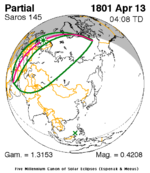 April 13, 1801 |
 April 24, 1819 |
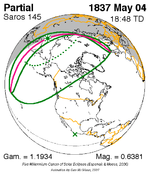 May 4, 1837 |
| 13 | 14 | 15 |
 May 16, 1855 |
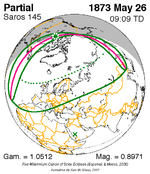 May 26, 1873 |
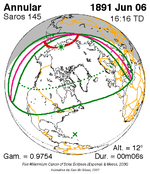 June 6, 1891 |
| 16 | 17 | 18 |
 June 17, 1909 |
 June 29, 1927 |
 July 9, 1945 |
| 19 | 20 | 21 |
 July 20, 1963 |
 July 31, 1981 |
 August 11, 1999 |
| 22 | 23 | 24 |
 August 21, 2017 |
 September 2, 2035 |
 September 12, 2053 |
| 25 | 26 | 27 |
 September 23, 2071 |
 October 4, 2089 |
 October 16, 2107 |
| 28 | 29 | 30 |
 October 26, 2125 |
 November 7, 2143 |
 November 17, 2161 |
| 31 | 32 | |
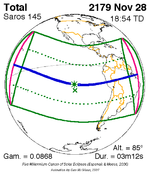 November 28, 2179 |
 December 9, 2197 | |
Metonic series
[edit]The metonic series repeats eclipses every 19 years (6939.69 days), lasting about 5 cycles. Eclipses occur in nearly the same calendar date. In addition, the octon subseries repeats 1/5 of that or every 3.8 years (1387.94 days). All eclipses in this table occur at the Moon's ascending node.
| 22 eclipse events between December 13, 1898 and July 20, 1982 | ||||
|---|---|---|---|---|
| December 13–14 | October 1–2 | July 20–21 | May 9 | February 24–25 |
| 111 | 113 | 115 | 117 | 119 |
 December 13, 1898 |
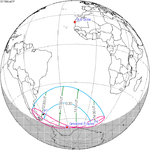 July 21, 1906 |
 May 9, 1910 |
 February 25, 1914 | |
| 121 | 123 | 125 | 127 | 129 |
 December 14, 1917 |
 October 1, 1921 |
 July 20, 1925 |
 May 9, 1929 |
 February 24, 1933 |
| 131 | 133 | 135 | 137 | 139 |
 December 13, 1936 |
 October 1, 1940 |
 July 20, 1944 |
 May 9, 1948 |
 February 25, 1952 |
| 141 | 143 | 145 | 147 | 149 |
 December 14, 1955 |
 October 2, 1959 |
 July 20, 1963 |
 May 9, 1967 |
 February 25, 1971 |
| 151 | 153 | 155 | ||
 December 13, 1974 |
 October 2, 1978 |
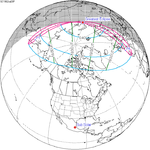 July 20, 1982 | ||
Tritos series
[edit]This eclipse is a part of a tritos cycle, repeating at alternating nodes every 135 synodic months (≈ 3986.63 days, or 11 years minus 1 month). Their appearance and longitude are irregular due to a lack of synchronization with the anomalistic month (period of perigee), but groupings of 3 tritos cycles (≈ 33 years minus 3 months) come close (≈ 434.044 anomalistic months), so eclipses are similar in these groupings.
The partial solar eclipses on December 7, 2170 (part of Saros 164) and November 7, 2181 (part of Saros 165) are also a part of this series but are not included in the table below.
| Series members between 1801 and 2105 | ||||
|---|---|---|---|---|
 September 28, 1810 (Saros 131) |
 August 27, 1821 (Saros 132) |
 July 27, 1832 (Saros 133) |
 June 27, 1843 (Saros 134) |
 May 26, 1854 (Saros 135) |
 April 25, 1865 (Saros 136) |
 March 25, 1876 (Saros 137) |
 February 22, 1887 (Saros 138) |
 January 22, 1898 (Saros 139) |
 December 23, 1908 (Saros 140) |
 November 22, 1919 (Saros 141) |
 October 21, 1930 (Saros 142) |
 September 21, 1941 (Saros 143) |
 August 20, 1952 (Saros 144) |
 July 20, 1963 (Saros 145) |
 June 20, 1974 (Saros 146) |
 May 19, 1985 (Saros 147) |
 April 17, 1996 (Saros 148) |
 March 19, 2007 (Saros 149) |
 February 15, 2018 (Saros 150) |
 January 14, 2029 (Saros 151) |
 December 15, 2039 (Saros 152) |
 November 14, 2050 (Saros 153) |
 October 13, 2061 (Saros 154) |
 September 12, 2072 (Saros 155) |
 August 13, 2083 (Saros 156) |
 July 12, 2094 (Saros 157) |
 June 12, 2105 (Saros 158) | ||
Inex series
[edit]This eclipse is a part of the long period inex cycle, repeating at alternating nodes, every 358 synodic months (≈ 10,571.95 days, or 29 years minus 20 days). Their appearance and longitude are irregular due to a lack of synchronization with the anomalistic month (period of perigee). However, groupings of 3 inex cycles (≈ 87 years minus 2 months) comes close (≈ 1,151.02 anomalistic months), so eclipses are similar in these groupings.
| Series members between 1801 and 2200 | ||
|---|---|---|
 October 29, 1818 (Saros 140) |
 October 9, 1847 (Saros 141) |
 September 17, 1876 (Saros 142) |
 August 30, 1905 (Saros 143) |
 August 10, 1934 (Saros 144) |
 July 20, 1963 (Saros 145) |
 June 30, 1992 (Saros 146) |
 June 10, 2021 (Saros 147) |
 May 20, 2050 (Saros 148) |
 May 1, 2079 (Saros 149) |
 April 11, 2108 (Saros 150) |
 March 21, 2137 (Saros 151) |
 March 2, 2166 (Saros 152) |
 February 10, 2195 (Saros 153) |
|
Notes
[edit]- ^ "July 20, 1963 Total Solar Eclipse". timeanddate. Retrieved August 7, 2024.
- ^ "Moon Distances for London, United Kingdom, England". timeanddate. Retrieved August 7, 2024.
- ^ Smiley, Charles H. (February 1964). "Racing the Moon's Shadow on July 20, 1963". Journal of the Royal Astronomical Society of Canada. 58 (1): 10–12. Bibcode:1964JRASC..58...10S.
The United States Air Force provided an F-104D, a Starfighter made by Lockheed, and Major William A. Cato piloted the plane from Kirkland Air Force Base in New Mexico to Uplands Airport, Ottawa. Since the duration of totality depends on the difference between the speed of the plane and the speed of the moon's shadow, we elected to fly north-west to meet the shadow, then turn and increase speed so that we would reach our maximum speed at 42,000 feet as the shadow overtook us and we continued to climb, attaining 48,000 feet as the shadow left us.
- ^ "毛利衛さん宇宙特別授業「宇宙からの贈りもの」". バンクーバー新報 (in Japanese). October 14, 2011.
- ^ "Operation Eclipse-1963 (An Airborne Expedition to Observe the Total Eclipse of the Sun of July 20, 1963)". Journal of the Royal Astronomical Society of Canada. 57 (6): 241–252. December 1963. Archived from the original on September 16, 2017.
- ^ Covington, A. E., Kennedy, W. A. G., & Gagnon, H. P. A. "2700 Mc/s Radio Observations of the Sun During the Total Eclipse of July 20, 1963". Journal of the Royal Astronomical Society of Canada. 60: 215–220. Archived from the original on September 16, 2017.
{{cite journal}}: CS1 maint: multiple names: authors list (link) - ^ "Past Solar Eclipses & Expeditions". Royal Astronomical Society of Canada. Archived from the original on April 21, 2016.
- ^ Schulz, Charles (July 20, 1963). "Peanuts by Charles Schulz for July 20, 1963 | GoComics.com". GoComics. Retrieved November 21, 2021.
- ^ AMC (2011). Episode 7: Seven Twenty Three (Details tab). Originally retrieved from http://www.amctv.com/shows/mad-men/episodes/season-3/seven-twenty-three. Archived on 2011-04-11 at https://web.archive.org/web/20110411231230/http://www.amctv.com/shows/mad-men/episodes/season-3/seven-twenty-three.
- ^ "Total Solar Eclipse of 1963 Jul 20". EclipseWise.com. Retrieved August 7, 2024.
- ^ van Gent, R.H. "Solar- and Lunar-Eclipse Predictions from Antiquity to the Present". A Catalogue of Eclipse Cycles. Utrecht University. Retrieved October 6, 2018.
- ^ "NASA - Catalog of Solar Eclipses of Saros 145". eclipse.gsfc.nasa.gov.
References
[edit]- Earth visibility chart and eclipse statistics Eclipse Predictions by Fred Espenak, NASA/GSFC




